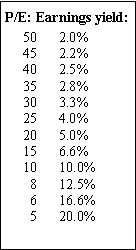Two Tools for Your Investor Tool Box
by Porter Stansberry
Your first order of business as an investor is: don't lose money. You should never be in a position to receive a Zerotrade statement in the mail. While I've made a career of finding speculative opportunities the majority of your equity investments should be in stocks that represent outstanding value on an operating basis. To find stocks like that, you need good tools to evaluate value and to ensure a margin of safety for your investment. These two simple tests should help.
TOOL #1: Instead of using PIE ratios to measure the value of stocks, I want to talk about "earnings yield" instead. What is earnings yield? It's the PIE ratio measured in the opposite way.
For example, if a stock is trading at 15 times earnings, it has an earnings yield of 1/15, or 6.6%.
Looking closely at earnings yield is the first step towards measuring value. It allows you to make a quick and simple comparison between stocks and bonds, which will prevent you from ever paying too much for a stock.
Let me explain how to do it. Ten-year corporate bonds yield 6.37%, according to Moody's. You could earn this return through investing in any number of no-load corporate bond funds. That's what's good about bonds: you know how much you'll make. With stocks, earnings will fluctuate, but you can nevertheless approximate the same kind of yield from equity. You figure a company's earnings yield by simply inverting its P/E ratio. I've done so for you below.

Today the S&P 500 is trading for around 22 times this year's estimated earnings. Thus, as an equity owner, you will have an earnings yield of about 4.5% in blue chip stocks. Bonds represent better value. Bonds are paying out over 6%, with little risk. Stocks are only earning 4.5%, with lots of risk. It's not surprising to see stocks decline, given the clear advantage in bonds.
Of course, what's true of the market as a whole doesn't apply to every stock in the market in equal measure. For example, let's look at a company I've recommended before. I studied its business carefully. You can see this trend easily with a simple analysis of the firm's results: revenue doubled in 2002, after rising 28%, on average, each year for past five years. I won't keep you in suspense. The company is Exelon (NYSE: EXC) and it's growing because of its superior technology (nuclear power) and its financial conservatism. As the rest of the power sector implodes, this firm is quietly - and profitably - picking up the pieces. The company's earnings yield, when I recommended it, exceeded 10% a year. And it paid a dividend of nearly 4% too. This was a growth stock that offered far more yield than a bond...and almost as much annual income.
TOOL #2: Exelon passed the earnings yield test. It was paying 50% more than bonds of similar quality...But how do you know it's a safe stock to buy?
I measure safety by figuring out if the company I'm looking at can afford to buy itself. Are the balance sheet assets and the cash flow of the company strong enough to accept new debt equal to the current market cap?
The market values Exelon for around $15 billion (after discounting the cash on its balance sheet). Assuming the same interest rate we've been measuring against (AAA bonds) of 6.37%, management would have to borrow around $15 billion to buy back all of the stock. Interest on this debt comes to $955 million per year.
In 2001, Exelon made $3.6 billion in profits and spent $2 billion on capital expenditures. It also paid $500 million in dividends. Or, in other words, it had around $1 billion in cash flow - enough to carry the debt without canceling the dividend. And 2002 earnings are stronger than last year. Yes, this company could afford to buy itself.
When a company has a strong enough balance sheet and a strong enough business to buy back all of its stock - at least on paper - you have a large margin of safety. Essentially this gives you the same risk as a bondholder, which makes your greater earnings yield that much more attractive. You're only taking the risks of debt holder, while you will get the return of an owner.




